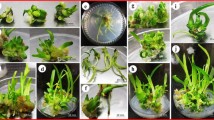Abstract
Eugenia myrtifolia Sims. is an evergreen shrub, native to temperate and tropical rainforests of Australia, which is becoming an important containerized ornamental plant in the US and Mediterranean nursery industries. To satisfy the growing market demands for this new ornamental plant, development of an accelerated propagation method is required. The goal of this study was to investigate the in vitro regeneration potential of E. myrtifolia Sims. seeds at different stages of development, towards establishment of an in vitro multiplication system. Maximum regeneration of adventitious shoots was achieved from immature seeds cultured in the dark on half-strength Murashige and Skoog (MS) macronutrients and full-strength MS micronutrients and vitamins (MS/2) medium supplemented with 2.5 μM thidiazuron (TDZ). Induction of regeneration occurred after at least two successive subcultures on TDZ-enriched medium, followed by subcultures on expression medium (hormone free MS/2) or multiplication medium [MM; MS medium enriched with 4.4 M 6-benzyladenine and 0.05 M α-naphthaleneacetic acid], where complete development of shoots occurred. The regenerated shoots were excised and transferred again onto MM for micropropagation, where a proliferation rate of 1:4 was achieved, and finally the shoots were transferred to a hormone-free MS medium for rooting. Following ex vitro transplanting, acclimatization over a period of 15 d was sufficient to establish greenhouse plants. The regenerated plants grown in the field for more than 2 yr showed the same phenotype as that of mother plants. The adventitious regeneration and micropropagation carried out in this study can be used for a large-scale propagation and genetic engineering of E. myrtifolia Sims.





Similar content being viewed by others
References
Elhiti M, Stasolla C (2011) The use of zygotic embryos as explants for in vitro propagation: an overview. In: Thorpe TA, Yeung EC (eds) Plant embryo culture: methods and protocols. methods in molecular biology, vol 710. Springer, Dordrecht, pp 229–255
George EF, Sherrington PD (1984) Plant propagation by tissue culture—handbook and directory of commercial laboratories. Exegetics Limited, Basingstoke, UK
Huetteman CA, Preece JE (1993) Thidiazuron: a potent cytokinin for woody plant tissue culture. Plant Cell Tiss Organ Cult 33:105–119
Jones MPA, Yi Z, Murch SJ, Saxena PK (2007) Thidiazuron-induced regeneration of Echinacea purpurea L.: micropropagation in solid and liquid culture systems. Plant Cell Rep 26:13–19
Larkin PJ, Scowcroft WR (1981) Somaclonal variation—a novel source of variability from cell cultures for plant improvement. Theor Appl Genet 60:197–214
Lebrun A, Toussaint AN, Roggemans J (1998) Description of Syzygium paniculatum Gaertn. ‘Verlaine’ and its propagation by stem cuttings. Sci Hortic 75:103–111
Motulsky HJ, Chrisopoulos A (2003) Fitting models to biological data using linear and nonlinear regression. A practical guide to curve fitting. GraphPad Software Inc., San Diego. www.graphpad.com
Murashige T, Skoog F (1962) A revised medium for rapid growth and bioassays with tobacco tissue cultures. Physiol Plant 15:473–497
Murthy BN, Murch SJ, Saxena PK (1998) Thidiazuron: a potent regulator of in vitro plant morphogenesis. In Vitro Cell Dev Biol Plant 34:267–275
Parra R, Amo-Marco JB (1998) Secondary somatic embryogenesis and plant regeneration in myrtle (Myrtus communis L.). Plant Cell Rep 18:325–330
Thurlby KAG, Connelly C, Wilson PG, Rossetto M (2011) Development of microsatellite loci for Syzygium paniculatum (Myrtaceae), a rare polyembryonic rainforest tree. Conserv Genet Resour 3:205–208
Acknowledgements
The authors would like to thank Dr. M. Beruto for useful advice. We also thank Mr. Gervasio and Mr. Protasio Tarantino, from ‘Vivai Tarantino’ (Lecce), for providing the plant material. This work was supported by Apulia Region, Italy. Project PS070.
Author information
Authors and Affiliations
Corresponding author
Additional information
Editor: J. Forster
This paper is dedicated to the memory of Dr. Carmine Damiano, teacher and friend.
Rights and permissions
About this article
Cite this article
Blando, F., Onlu, S., Colella, G. et al. Plant regeneration from immature seeds of Eugenia myrtifolia Sims.. In Vitro Cell.Dev.Biol.-Plant 49, 388–395 (2013). https://doi.org/10.1007/s11627-013-9502-3
Received:
Accepted:
Published:
Issue Date:
DOI: https://doi.org/10.1007/s11627-013-9502-3




